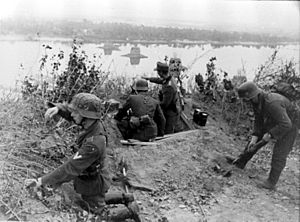Battle of the Dnieper facts for kids
Quick facts for kids Battle of the Dnieper |
|||||||||
|---|---|---|---|---|---|---|---|---|---|
| Part of the Eastern Front of World War II | |||||||||
 German soldiers fighting across the Dnieper River during battle in1943 |
|||||||||
|
|||||||||
| Belligerents | |||||||||
| Commanders and leaders | |||||||||
| Units involved | |||||||||
| Strength | |||||||||
| 26 August: 2,633,000 men 51,200 guns and mortars 2,400 tanks and assault guns 2,850 combat aircraft |
1,250,000 men 12,600 guns and mortars 2,100 tanks and assault guns 2,000 aircraft | ||||||||
| Casualties and losses | |||||||||
|
1,687,164 men
|
281,407 men (21 August – 20 December)
|
||||||||
The Battle of the Dnieper was a massive military event during World War II. It took place from August to December 1943. This battle involved about four million soldiers from the Soviet Union and Nazi Germany. They fought for control over a huge area, including the important Dnieper River in the Soviet Union. The Dnieper River is one of Europe's longest rivers. The battle ended with a big victory for the Soviet Union.
Contents
What Was the Battle of the Dnieper?
The Battle of the Dnieper was one of the largest battles in history. It was a key part of the Eastern Front of World War II. This front was where Germany fought the Soviet Union. The battle covered a front line of about 870 miles (1,400 kilometers). It lasted for nearly four months.
Why Was the Dnieper River Important?
The Dnieper River was a major natural barrier. It flows through Ukraine, which was part of the Soviet Union. For the German army, holding the Dnieper line was very important. It was a strong defensive position. For the Soviet army, crossing the river was key to pushing the Germans back. It would help them take back lost territory.
Who Fought in This Huge Battle?
The main forces fighting were the Soviet Red Army and the German Wehrmacht. The Soviet Union also had help from Czechoslovak soldiers. Germany was supported by forces from the Kingdom of Romania.
Soviet Commanders and Their Armies
The Soviet forces were led by several top generals. These included Georgy Zhukov and Aleksandr Vasilevsky. They commanded large groups of armies called "Fronts." These included the 1st, 2nd, 3rd, and 4th Ukrainian Fronts. They also had the 1st Belorussian Front.
German Commanders and Their Armies
On the German side, key commanders were Erich von Manstein and Paul Ludwig Ewald von Kleist. They led powerful groups like Army Group South and Army Group A. These groups included several Panzer (tank) armies and infantry armies.
How Did the Battle Unfold?
The battle began with the Soviet army pushing hard against the Germans. The Germans were trying to retreat to the Dnieper River. They wanted to set up strong defenses there. The Soviets chased them closely, not giving them time to fully prepare.
Crossing the Dnieper River
The most challenging part was crossing the wide Dnieper River. Soviet soldiers used anything they could find. They used small boats, rafts, and even logs. They crossed under heavy German fire. They established small areas on the western bank called "bridgeheads." These were like small footholds.
Capturing Kiev
One of the main goals for the Soviets was to recapture Kiev. Kiev is the capital city of Ukraine. It was a very important city. After fierce fighting, Soviet forces managed to take Kiev in early November 1943. This was a huge victory.
What Was the Outcome and Importance?
The Battle of the Dnieper was a major Soviet victory. It showed that the Soviet army could carry out large, complex attacks. They pushed the German army far back.
Impact of the Soviet Victory
- The Soviet Union took back a lot of land. This included left-bank Ukraine and the important Donets basin.
- The Germans lost many soldiers and a lot of equipment.
- The victory boosted the morale of the Soviet people.
- It made it harder for Germany to hold its positions on the Eastern Front.
- The battle helped set the stage for further Soviet advances in World War II.
Images for kids
See also
 In Spanish: Batalla del Dniéper para niños
In Spanish: Batalla del Dniéper para niños







